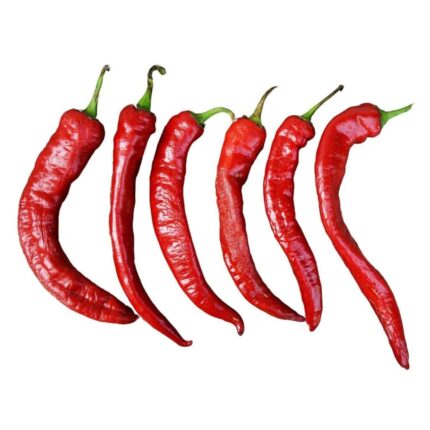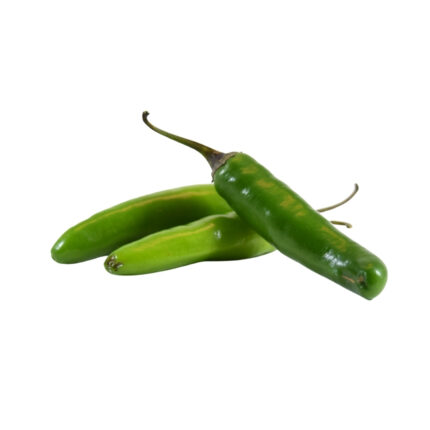~5 lbs (Approximate weight)
Seasonally sourced from California, Mexico, and Arizona. California red pepper generally starts in late October to early November.
Red Pepper aka “Red Bell Pepper”, “Red Sweet Pepper”, “Hong-Jiao”, “红椒”, “紅椒”
Red pepper is a plump, bell-shaped vegetable with a signature sweet and fruity flavor. Inside contains white piths and a cluster of small white seeds. The seeds are edible but are generally discarded. All sweet pepper starts green at the immature stage and turns color as they mature. Red pepper is the mature form of sweet pepper. Red pepper also comes in a longer, less rounded shape called le rouge. Most of our customers prefer the le rouge red pepper while the retail customer has a preference for the bell-shaped red pepper. Red pepper holds up well on the grill and is often grilled, roasted, and stuffed. Red pepper is available year-round.
Handling Tip
Selection
Red pepper is firm, plump, and bright red.
Red pepper shows no signs of crack, decay, or shriveled skin.
Avoid red pepper that has bruising shown on a contact spot. The contact spot is soft and yellowish-brown. This is where red pepper will start to go bad and eventually the water content within the pepper will be lost.
Storage
Red pepper should be stored at 45°F – 55°F (7°C – 13°C) with a relative humidity of ninety to ninety-five percent and no mist.
The typical shelf life is two to three weeks. Shelf life can be extended by another week by packaging in moisture-retentive films under optimal storage temperature. Storage temperature above 55°F (13°C) will accelerate ripening and bacterial soft rot.
Red pepper is sensitive to ethylene, a naturally occurring gas that regulates ripening. Red pepper should not be stored with high ethylene-producing products to extend shelf life and avoid softening. Red pepper produces a very low level of ethylene.
Red pepper is moderately sensitive to chilling injury at storage below 45°F (7°c). Symptoms include surface pitting, water-soaked areas, decay, and discoloration of the seed cavity.
Nutrition Fact
Serving Size 1 medium pepper (148g)
Amount Per Serving % Daily Value*
Calories 25
Calories from Fat 0
Total Fat 0g ………………………………………………………………………………. 0%
Saturated Fat 0g ……………………………………………………………….. 0%
Trans Fat 0g ………………………………………………………………………. 0%
Cholesterol 0mg ………………………………………………………………………. 0%
Sodium 40mg …………………………………………………………………………… 2%
Total Carbohydrate 6g ……………………………………………………………. 2%
Dietary Fiber 2g ………………………………………………………………… 8%
Sugar 4g
Protein 1g
Vitamin A ……………………………………………………………………………………… 4%
Vitamin C ………………………………………………………………………………….. 190%
Calcium ………………………………………………………………………………………… 2%
Iron ………………………………………………………………………………………………. 4%
Potassium ……………………………………………………………………………………. 6%
*The % Daily Value (DV) tells you how much a nutrient in a serving of food contributes to a daily diet 2,000 calories a day is used for general nutrition advice.
*Based on information published by FDA
Creating clear and transparent shipping and handling policies is crucial for a commodity trading company like Agropastoral Products Co., Ltd. Here's a framework for the Shipping and Handling Policy:
1. Shipping Policy:
a. Shipping Process: - Detail the steps involved in the shipping process, from order placement to delivery.
b. Shipping Rates: - Specify the shipping costs associated with various products or order amounts.
c. Delivery Timeframe: - Provide estimated delivery times based on location and shipping method.
d. Shipping Carriers: - Name the shipping carriers used and any partnerships that may influence shipping.
e. International Shipping: - Explain international shipping options, rates, and potential customs or import duties.
f. Tracking Information: - Describe how customers can track their orders and obtain tracking information.
g. Shipping Restrictions: - List any countries, regions, or products where shipping may be restricted or limited.
2. Handling Policy:
a. Packaging: - Describe how products are packaged to ensure safe transit and delivery.
b. Quality Assurance: - Explain any quality control measures or checks in place during the handling process.
c. Fragile Items: - Provide special handling instructions for fragile or delicate commodities.
d. Inventory Management: - Detail how inventory is managed to maintain accuracy and prevent errors in order fulfillment.
e. Returns and Exchanges: - Outline the process for handling returns, exchanges, or replacements related to shipping issues or damaged items.
3. Additional Policies:
a. Lost or Damaged Items: - Explain the procedure for reporting and addressing lost or damaged items during shipping.
b. Split Shipments: - Describe under what circumstances the company may split an order into multiple shipments and how this is communicated to the customer.
c. Free Shipping Offers: - Clarify conditions for free shipping, such as minimum order amounts or specific products.
d. Holiday or Peak Season Shipping: - Provide information about any special considerations or delays during peak seasons or holidays.
e. Force Majeure: - Address how the company handles unforeseen events like natural disasters, strikes, or other force majeure events affecting shipping and delivery.
f. Contact Information: - Provide contact details for customers to reach out for shipping-related queries, concerns, or support.
Regularly update and review these policies to ensure they align with your company's operations and any changes in shipping or handling processes. Communicating these policies clearly to your customers will help manage their expectations and provide a positive shopping experience.














Reviews
There are no reviews yet.